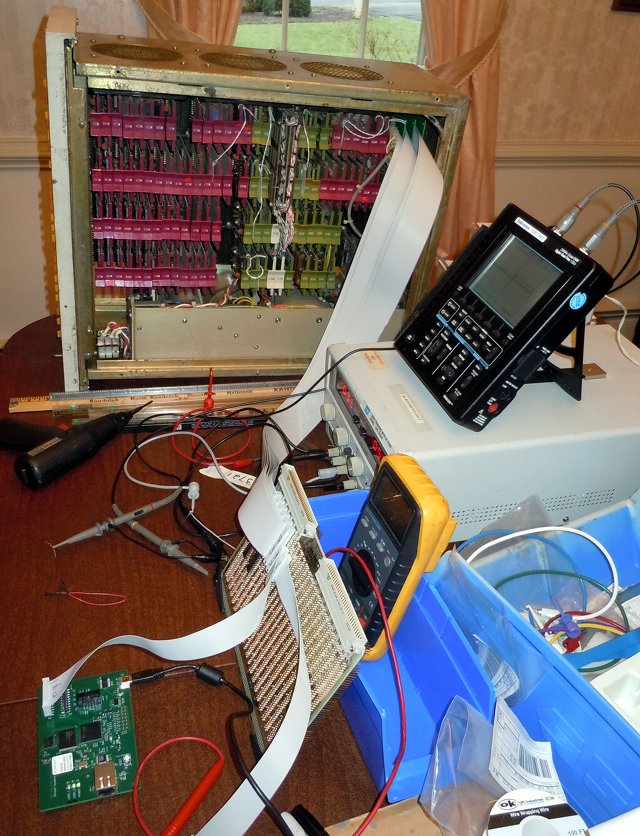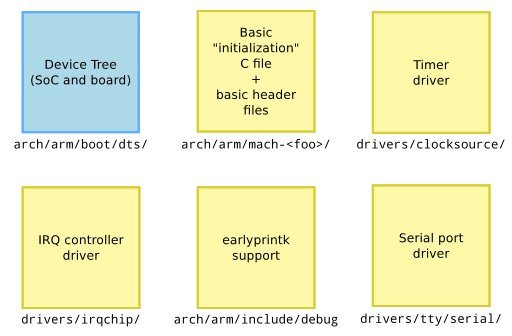According to Wikipedia, Digital Equipment Corporation (DEC) PDP-8 was the first successful commercial minicomputer, and was introduced in March 1965. Mike Thompson, working at Rhode Island Computer Museum (RICM), has restored a PDP-8/L system that was sold between 1968 through 1971. The system can be expanded with 4K of core, a paper tape reader (PR8/L), and/or a punch (PP8/L) controller. But the tape reader is not available anymore, so Mike decided to designe a Posibus peripheral (Tape Reader) emulator using a board with an FPGA + micro-controller. The easiest way to perform this task was to get an SoC that comes with an MCU and a FPGA to avoid having to create an FPGA <-> MCU interface. This is why he chose Emcraft Linux SmartFusion Evaluation Kit featuring a Microsemi Smartfusion cSOC with a Cortex M3 core and an embedded FPGA. The whole setup is shown below. Three FlipChip interface boards […]
Board Bringup: You, Me, and I2C – ELCE 2012
David Anders, embedded systems developer at Texas Instruments, explains how to work with I2C in Linux based embedded systems at ELCE 2012. Abstract: Board bring up is one of the most under documented aspects of embedded development. I2C is such a powerful, low-cost, and ubiquitous method of communication, that a basic understanding of it’s usage is essential to the embedded linux developer to quickly bring up and debug embedded designs. This presentation will look at the various software and hardware aspects of working with I2C using simple case studies highlighting the implementation of an EEPROM and a GPIO Expander. Most embedded Linux developers at some point in their career will be handed a piece of hardware that is untested. This presentation intends to provide some information about core tools and methods for bring up of I2C interfaces and assorted I2C based peripheral devices. David Anders has previously presented at Embedded […]
Your New ARM SoC Linux Support Check-List – ELCE 2012
Thomas Petazzoni, embedded Linux engineer and trainer at Free Electrons, describes the steps he followed to add a new Marvell SoC to the mainline kernel at ELCE 2012. Abstract: Since Linus Torvalds raised warnings about the state of the ARM architecture support in the Linux kernel, a huge amount of effort and reorganization has happened in the way Linux supports ARM SoCs. From the addition of the device tree to the pinctrl subsystem, from the new clock framework to the new rules in code organization and design, the changes have been significant over the last one and half year in the Arm Linux kernel world. Based on the speaker’s experience on getting the support for the new Marvell Armada 370 and Armada XP SoC support in the mainline Linux kernel, we will give an overview of those changes and summarize the new rules for ARM Linux support. We aim at […]
USB Debugging and Profiling Techniques – ELCE 2012
Kishon Vijay Abraham and Basak Partha, respectively software design engineer and tech lead at Texas Instruments, provide an overview of techniques that can be used to debug Linux USB drivers on the host PC or/and the device itself. Abstract: The widespread integration of USB into embedded applications presents many developers with the challenge of debugging problems, that are difficult to detect and isolate when a USB device misbehaves. This paper discusses about the various USB debugging techniques which includes debugging at the host PC, at the device and in the cable and discuss when each of the above techniques will be handy. This paper will also discuss about the various facilities provided within Linux kernel to aid in USB debugging e.g sysfs, trace points etc. and the various user space tools available to help USB debugging e.g USBMON. This paper also discusses about the profiling techniques at various levels in […]
Wireless Networking with IEEE 802.15.4 and 6LoWPAN – ELCE 2012
Alan Ott, founder of Signal 11 Software, gives a presentation dealing with wireless networking for the internet of things in Linux, especially with 802.15.4 and 6LoWPAN standards at the Embedded Linux Conference in Barcelona, Spain on November 5, 2012. Abstract: With the rise of the internet of things, low-power wireless devices will become increasingly prevalent. IEEE 802.15.4 is a wireless networking protocol designed for low-power and low-data-rate devices, such as those used in wireless sensor networks. While some higher layer protocols based on 802.15.4 are proprietary, an open standard called 6LoWPAN enables IPv6 traffic over 802.15.4. This presentation will give overviews of 802.15.4, its status in the Linux kernel, hardware support, comparison with other wireless protocols, and a demonstration of a simple 802.15.4/6loWPAN network. This presentation is targeted toward developers who wish to create low-power, low-data-rate wireless networks for sensors or other applications. Attendees can expect to gain a basic […]
Modular Graphics on Embedded ARM – ELCE 2012
Philipp Zabel, kernel developer at Pengutronix, discusses about graphics and video support for Linux on embedded SoCs at Embedded Linux Conference Europe 2012. Abstract: Porting Linux to new ARM based application processors has recently become easier than ever: the kernel gained many new frameworks like common-clock, oftree and pinmux. However, things get complicated when it comes to high end embedded graphics units.Those graphics systems tend to be composed of a multitude of on-SoC functional blocks that can operate on shared graphics buffers and video signals, as well as off-SoC encoder/converter chips that can be mixed and matched with any SoC.The old framebuffer is certainly not enough for today’s hardware any more, while modern frameworks like KMS and DRM have their own hassles on non-PC style graphics systems.The talk outlines issues we found while working on graphics and video support for the MX53 and MX6 CPUs and gives suggestions for possible […]
Inside Android’s User Interface – ELCE 2012
Karim Yaghmour, Opersys inc, talks about the internals of the Android user interface at Embedded Linux Conference Europe on November 5, 2012. Abstract: Android is a very complex stack comprising several dozens of novel components and moving parts. Still, it’s intrinsically a user-centric system and, therefore, its parts which deal with user interface are of special interest for anyone aiming to put Android in a device. This talk will examine the internals of Android’s user-facing components. Specifically, we will cover the inner-workings and interactions of the Window Manager, Surface Flinger, Input Method Manager, and the rest of the system. We will also cover key display and input components such as the Status Bar, Soft Keyboard and Notifications. This talk will be especially useful to developers intending to use Android in user-facing embedded systems, those needing to implement support for their graphics hardware and anyone interested in the internals of Android’s […]
Etnaviv Project Vivante GCxxx GPU Open Source Driver
You have most probably heard of Lima, an initiative to provide fully open source Mali-200 & Mali-400 drivers by reverse-engineering the closed source Mali GPU drivers. A separate effort, Etnaviv Project, has now started to offer open source drivers for Vivante GCxxx GPU used in SoC such as Marvell Armada 1500 (notably used in mainly Google TV platforms), Rockchip RK2918 (present in many older tablets), Freescale i.MX6 (used in newer tablets, low cost development boards, some SoMs and GK802/Hi802 mini PCs). The project is called Etnaviv. The introduction of Etnaviv Project reads as follows on the corresponding Github account: Project Etnaviv is an attempt to make an open source user-space driver for the Vivante GCxxx series of embedded GPUs. The current state of the project is experimental. It is currently only of use to developers interested in helping develop open source drivers for the hardware, reverse engineering, or in interfacing […]










